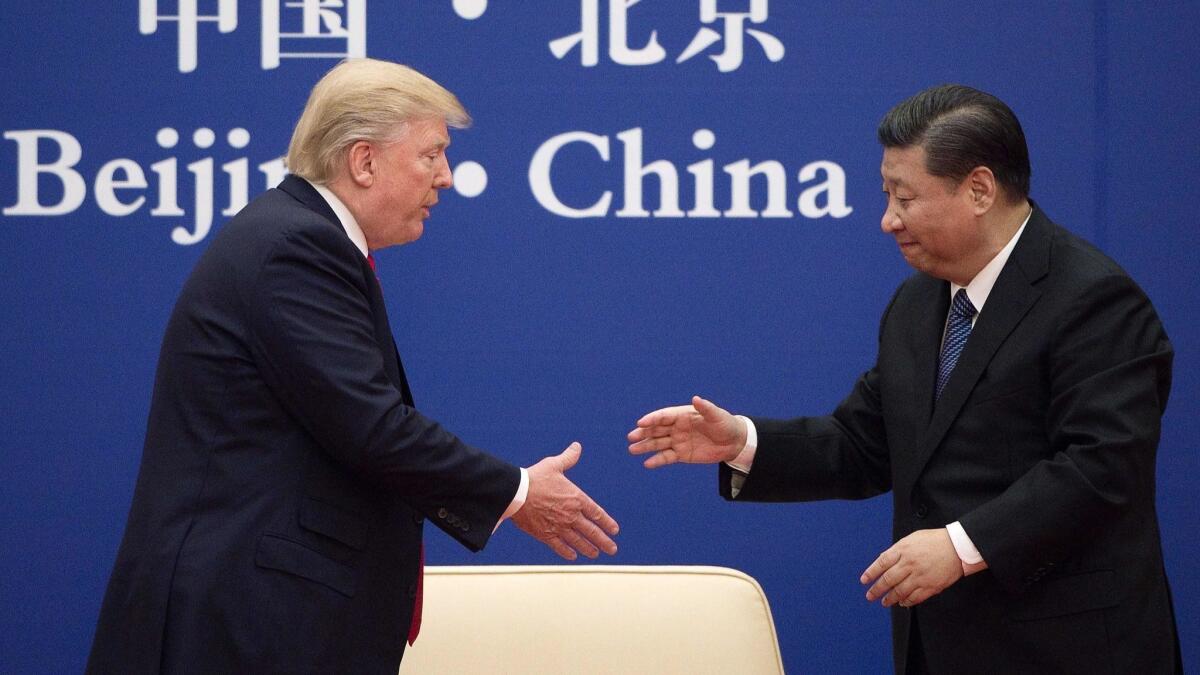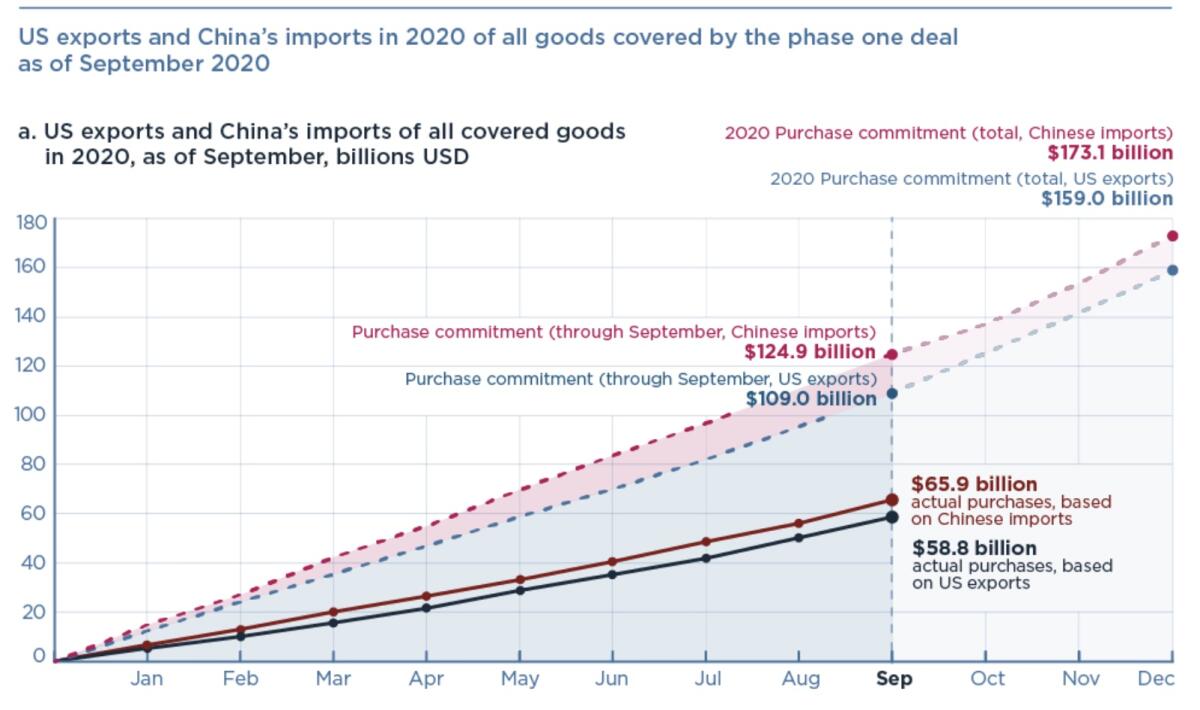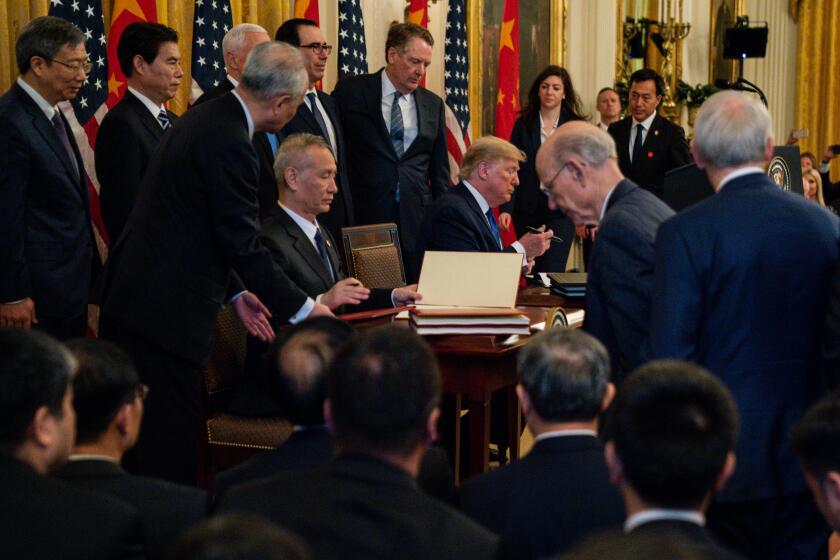Column: How China took Trump to the cleaners in their big trade deal

- Share via
January seems so long ago it’s almost prehistoric, but if you can cast your mind back that far you’ll recall that President Trump signed a big deal signifying a cease-fire in his incredibly destructive trade war with China.
The so-called Phase 1 deal called for China to step up its purchases of U.S. goods and produce by $200 billion over two years. The idea was to shrink China’s enormous trade surplus with the U.S., which had reached a record $323.3 billion in 2018.
Trump called the agreement, signed with Chinese Vice Premier Liu He at a White House ceremony Jan. 15, “transformative.”
China is buying more farm products each month, but still well below the pace it would need to meet the year-end target. So it’s got a lot of buying it needs to do in October-November-December.
— Chad P. Bown, Peterson Institute for International Economics
Sadly, no. The latest trade figures, ably collated and analyzed by Chad P. Bown of the Peterson Institute for International Economics, show that China has fallen far behind on its purchase commitments. So far behind, Bown says, that the chances it will meet its year-end 2020 commitments are effectively nil.
As of Sept. 30, Bown calculates, China has purchased only about half as much from the U.S. as it should have bought by that point in the year. It’s possible that China will step up purchases over the last three months of 2020 in some sectors such as agriculture.
“China is buying more farm products each month,” Bown told me. “But still well below the pace it would need to meet the year-end target. So it’s got a lot of buying it needs to do in October-November-December.”
And that’s just agricultural products, which count for only about 22% of the trade commitment. For manufactured products, which account for 70% of the trade deal, “there’s no chance that we’re going to get there for 2020.”
President Trump has declared victory in the trade war with China -- but America has paid all the price.
Some of the shortfall isn’t all the fault of Trump’s ostensibly legendary but actually dubious negotiating skills.
The pandemic, which wasn’t on anyone’s radar screen, at least in terms of its ultimate scale, has cut the volume of international trade economy significantly. With travel at a low ebb, China has no incentives to follow through on aircraft purchases that were expected to play a major role in its manufacturing imports.
Another factor is an outbreak of swine fever that may result in the forced destruction of half of China’s pigs this year, or a quarter of the world’s supply. That reduces China’s demand for soybeans, a key feed protein. Soybeans were a major component of China’s agricultural import commitment, but with a major source of demand disappearing, so will soybean purchase volumes.
But some of the shortfall can be blamed on the terms of the deal Trump signed. The agreement didn’t wipe the slate clear of most of the tariffs Trump had earlier placed on Chinese goods, so the retaliatory tariffs China had imposed also remained.
As Bown observes, those include U.S. tariffs on parts needed by U.S.-based auto manufacturers to build cars in the U.S., which increases the price of the vehicles exported to China, reducing Chinese demand.

To overcome that obstacle, U.S. manufacturers transferred production to China — Tesla autos that would have been built in California are now made in Shanghai, and SUVs that would have been turned out by a BMW plant in Spartanburg, S.C., are now made in China too.
In other words, Trump’s own trade policies worked against his own “transformative” trade deal.
The Phase 1 deal also counted on robust purchases of crude oil and liquified natural gas from the U.S. Indeed, it counted on such high volumes of petroleum products that the oil and gas industry warned that the U.S. couldn’t produce enough to fulfill the terms.
Another problem is that the deal measured China’s purchases of these commodities in dollar terms. The pandemic, however, has driven down fossil fuel prices — even briefly to negative prices, signifying that more oil was sloshing around in the markets than could be stored.
“When the pandemic hit and the price of oil went to zero,” Bown says, “you could pull as many barrels as you want out of the ground and ship it to China, but you’re not going to get far to meeting those purchase commitments.”
As for aircraft, while the pandemic may have unexpectedly cut demand for new planes, China was expected to fulfill its target with purchases of Boeing’s 737 Max.
Boeing will be hobbled by the 737 Max affair for years to come. Yet the board that oversaw this calamity is not being held to task.
Manufacturing of that plane was placed on hold after two crashes of the aircraft in 2018 and 2019, taking 346 lives. But the consequences of those crashes on the aircraft’s production schedule were known by the time of the Phase 1 deal, so counting on those purchases to help meet the target was overly ambitious.
It was never very clear whether the Phase 1 deal meant that China was serious about its import commitments. Many experts called the goals “ambitious,” which as I wrote at the time was a polite way of saying “unlikely.”
The Phase 1 deal committed China to buying at least $63.9 billion more of U.S. goods, relative to 2017 import volumes, by the end of 2020, and more by the end of 2021. That works out to $173.1 billion in imports by the end of this year.
Prorated to the end of September, China’s commitment was for $124.9 billion for the first three quarters of the year. By that point, however, China had made only $65.9 billion in import purchases, or less than 53%. China only has to meet its 2020 target by the end of the year, so it’s not technically in violation yet.
But the path ahead of the country is steep. It would have to cram almost half a year’s purchases of produce and manufactured goods into the last three months of the year, and quadruple its energy purchases over that timespan to hit the target.
In sum, the deal that Trump proclaimed as a sign of victory in his trade war is coming apart at the seams. That’s not surprising, given how badly the trade war has fared on all other fronts. Trump’s tariffs have imposed billions of dollars in costs on American consumers, who pay the bill (never mind Trump’s inaccurate claim that they’re paid by China).
They’ve deprived U.S. farmers of their most important export market and forced American manufacturing jobs to go overseas. Trump tried to paper over these glaring flaws with a deal that China probably knew he couldn’t enforce. One would think China taught Trump a lesson in patient and canny deal-making, except that Trump hasn’t shown a capability for learning any lesson.
More to Read
Inside the business of entertainment
The Wide Shot brings you news, analysis and insights on everything from streaming wars to production — and what it all means for the future.
You may occasionally receive promotional content from the Los Angeles Times.












